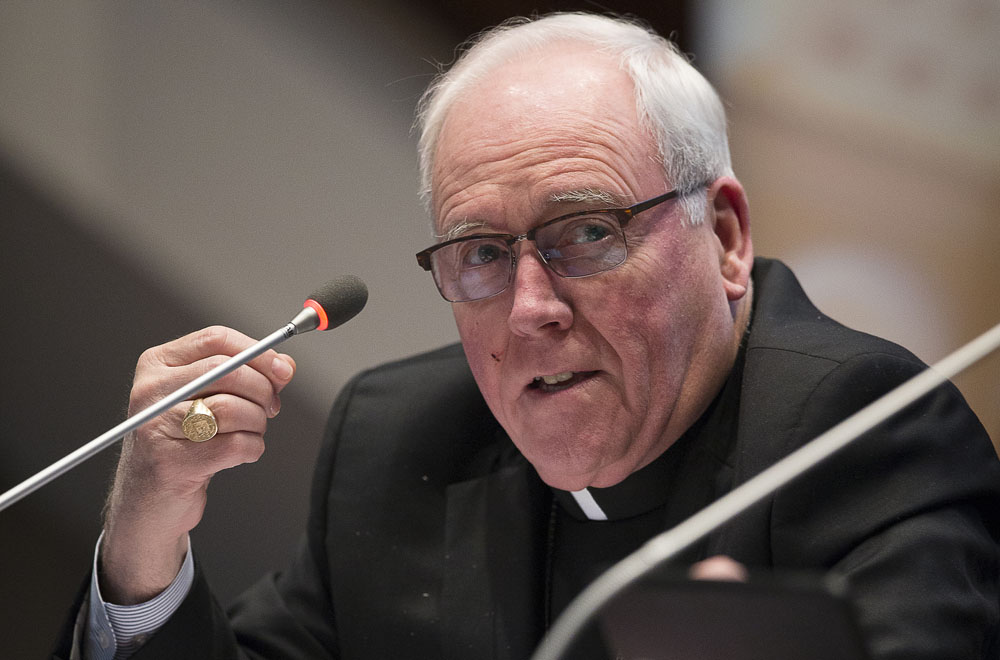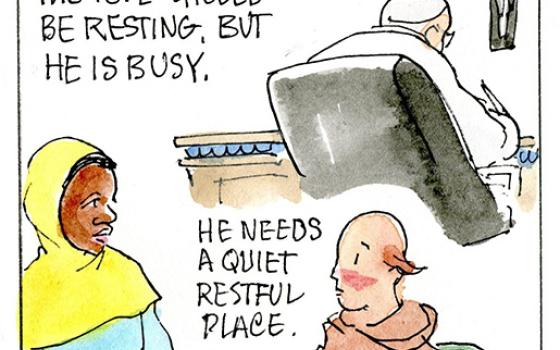
Bishop Richard Malone of Buffalo, New York, speaks during a meeting to discuss Catholic education at the headquarters of the U.S. Conference of Catholic Bishops, Jan. 17, in Washington. (CNS/Tyler Orsburn)
Catholics in Buffalo, New York, are undergoing their Boston moment on sex abuse, 16 years removed from the events that rocked the wider church in the United States.
On Feb. 27, Michael Whalen, 52, held a press conference at which he accused retired priest Fr. Norbert Orsolits of abuse inflicted when Whalen was a minor. Orsolits, now 78, told a Buffalo News reporter that he was guilty of dozens of such crimes, had undergone therapy at a rehabilitation facility in Canada, and then returned to the diocese as an active priest, until being removed from ministry and forced to retire in 2003. His early retirement was a result of the charter enacted by the U.S. bishops in Dallas in 2002, which prohibited ministry by any priest credibly accused of sex abuse.
Orsolits' story was news to Catholics in Buffalo, who were never told that the priest was an accused sex abuser. The diocese was taken to task for a policy of not revealing the names of accused priests. Within weeks, Bishop Richard Malone, who came to the diocese in 2012, revealed the names of 42 accused clergy.
In early June, Malone told the Buffalo News that the diocese is being transparent. "There's nothing being hidden," he said, adding that any delays in sending out information is due to locating victims and respecting confidentiality agreements. "When we get a judgement, it will be public," he said.
The controversy continues. Media reports offered cascading accounts of priest abuse survivors who came forth to tell their stories. On July 10, WKBW, the ABC TV affiliate in Buffalo, announced that it had compiled a list of 74 names of current or former priests in the diocese accused of sex abuse going back decades.
Because of the statute of limitations on such crimes, only five accused priests have been prosecuted.
The unrelenting news has stunned area Catholics. In one parish alone, Most Precious Blood Church in Angola, New York, four priests who served there at various times have been publicly accused.
"We were very shocked," Gary Starck, a parishioner at Nativity of the Blessed Virgin Mary Church, in Harris Hill, New York, told NCR. Starck, 81, active in his parish as a Eucharistic minister, said that Catholics want to know "why was this put under the rug?"
The public revelations caused him to reflect on his own experience in the church, including his childhood years as an altar boy in a Buffalo city parish, supervised by a priest who has been accused. He said that he was not abused, and, to the best of his knowledge, neither were his friends, who were all regularly part of outings supervised by the priest to a local country club.
"We can't believe this fellow was accused," he said. "But something happened."
Unlike Boston in 2002, the national media has largely ignored Buffalo's catastrophe. But Starck said the local media "pound on this every day." The stories have been unrelenting, including scores of accounts of accused priests being shuffled in previous eras from parish to parish. Some have questioned the media focus, arguing whether it is indicative of an anti-Catholic bias.
Fred Endres, another local Catholic, was ordained a priest of the diocese in 1962, and left ministry after getting married. The crisis in Buffalo, he said, "should not be without hope. Let the priests be married."
Endres is active in the Alliance to Restore the Married Priesthood. The Buffalo News agrees, editorializing in favor of the church allowing for married clergy as a response to the crisis.
While regulations for clerical celibacy remain in place, the Buffalo diocese is in difficult financial straits, with some blaming the impact of sex abuse settlements. Buffalo, similar to other New York dioceses, has implemented a program to allow sex abuse survivors to come forward and be provided compensation in a process supervised by an independent administrator.
The diocese has announced a series of belt-tightening moves over the past year, including the cancellation of its television productions, the closure of a campus ministry center and the end to subsidies for six diocesan high schools. One high school, Niagara Catholic, abruptly closed at the end of the school year. Malone put his $1 million mansion on the market and will move to humbler quarters at a formerly closed parish convent.
Advertisement
Fr. Jack Ledwon, pastor of St. Joseph University Parish in Buffalo, told NCR that the Buffalo experience has been intensified because its day of reckoning was put off by secrecy.
"It was a delayed reaction. We didn't deal with it back in 2002," he said. The Buffalo Diocese at the time was led by Bishop Henry Mansell, who became archbishop of Hartford, Connecticut, in 2003 and is now retired.
"It's taken its toll on everyone. It wears you down. You get very disappointed," Ledwon said.
Parishioners are angry, he said, because so many priest abusers were slow to be removed from ministry. He said victims have come forward to him, not seeking restitution, but rather an acknowledgement of the suffering they incurred as children decades ago. One man simply wanted "a recognition of the cross they [abuse survivors] have been carrying."
Ledwon spoke about the sex abuse disclosures on the third Sunday of Lent in his homily.
"I tried to contextualize it in terms of human weakness and that our primary focus has to be on the innocent. The role of the church should be an interest in healing," he said.
[Peter Feuerherd is a correspondent for NCR's Field Hospital series on parish life and is a professor of journalism at St. John's University, New York.]








